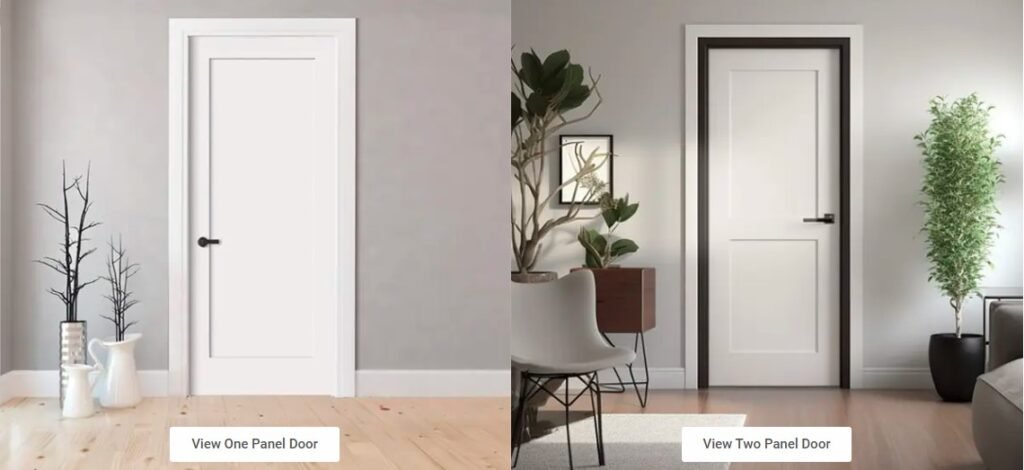When it comes to selecting doors for residential or commercial spaces, two common options are hollow core interior doors and fire-rated interior garage doors. Each serves a distinct purpose, offering unique benefits depending on the application.
In this blog, we’ll explore:
-
What hollow core interior doors are and their advantages/disadvantages
-
What fire-rated interior garage doors are and why they’re essential for safety
-
Key differences between the two
-
Best use cases for each type
By the end, you’ll have a clear understanding of which door type suits your needs.
1. Hollow Core Interior Doors: Lightweight and Affordable
What Is a Hollow Core Door?
A hollow core interior door is a lightweight door made with a thin veneer (usually wood or composite) over a honeycomb or grid-like cardboard core. These doors are commonly used for bedrooms, bathrooms, and closets in residential settings.
Advantages of Hollow Core Doors
✅ Cost-Effective – One of the most affordable door options, making them ideal for budget-conscious homeowners.
✅ Lightweight – Easy to install and handle, reducing strain on hinges and frames.
✅ Variety of Finishes – Available in multiple styles, colors, and textures to match interior décor.
✅ Sound Insulation (Basic) – While not as soundproof as solid core doors, they still provide some noise reduction.
Disadvantages of Hollow Core Doors
❌ Less Durable – Prone to dents and damage due to their lightweight construction.
❌ Poor Soundproofing – Not ideal for rooms requiring privacy (e.g., home offices or bathrooms).
❌ Not Fire-Resistant – Offers no fire protection, making them unsuitable for garages or fire-rated applications.
Best Uses for Hollow Core Doors
-
Bedrooms
-
Closets
-
Pantries
-
Laundry rooms
2. Fire-Rated Interior Garage Doors: Safety and Durability
What Is a Fire-Rated Interior Garage Door?
A fire-rated interior garage door is designed to resist fire and smoke for a specified period (typically 20 minutes to 90 minutes). These doors are often required by building codes for garages attached to homes or commercial spaces to prevent fire spread.
Advantages of Fire-Rated Garage Doors
✅ Fire Resistance – Slows the spread of flames and smoke, providing critical escape time.
✅ Enhanced Security – Made from sturdy materials (steel, solid wood, or fire-resistant composites).
✅ Insulation Properties – Some models offer thermal and sound insulation.
✅ Compliance with Building Codes – Required in many jurisdictions for attached garages.
Disadvantages of Fire-Rated Garage Doors
❌ Higher Cost – More expensive than standard garage doors due to specialized materials.
❌ Heavier Construction – Requires reinforced frames and strong hinges.
❌ Limited Aesthetic Options – Fewer design choices compared to hollow core doors.
Best Uses for Fire-Rated Garage Doors
-
Attached garages
-
Commercial buildings
-
Multi-family housing units
-
Any space requiring fire separation
3. Key Differences Between Hollow Core Doors and Fire-Rated Garage Doors
| Feature | Hollow Core Interior Door | Fire-Rated Interior Garage Door |
|---|---|---|
| Material | Thin veneer + cardboard core | Steel, solid wood, or fire-resistant core |
| Weight | Lightweight | Heavy-duty |
| Fire Resistance | None | 20-90 minutes (depending on rating) |
| Cost | Affordable | Expensive |
| Soundproofing | Minimal | Better (depending on model) |
| Durability | Low | High |
| Best For | Bedrooms, closets | Garages, fire-rated walls |
4. Which One Should You Choose?
Choose a Hollow Core Door If:
-
You need an affordable, lightweight option for non-critical spaces.
-
Aesthetics and cost are more important than durability.
-
The door is for a low-traffic area (e.g., a closet or pantry).
Choose a Fire-Rated Garage Door If:
-
The door leads to an attached garage (building codes often require this).
-
You need fire protection for safety compliance.
-
Durability and security are top priorities.
5. Installation and Maintenance Tips
Hollow Core Doors:
-
Ensure proper hinge support to prevent sagging.
-
Avoid excessive moisture, which can warp the door.
-
Use soft-close mechanisms to reduce wear and tear.
Fire-Rated Garage Doors:
-
Hire a professional installer to ensure proper sealing and alignment.
-
Check fire seals and automatic closing mechanisms regularly.
-
Never modify the door (drilling holes can compromise fire resistance).
Conclusion
Hollow core interior doors and fire-rated garage doors serve very different purposes. While hollow core doors are great for budget-friendly, lightweight applications, fire-rated garage doors are essential for safety and compliance in fire-prone areas.
Before making a decision, consider:
-
Building code requirements (especially for garages).
-
Budget constraints.
-
Long-term durability needs.
By understanding these differences, you can make an informed choice that balances aesthetics, functionality, and safety.







